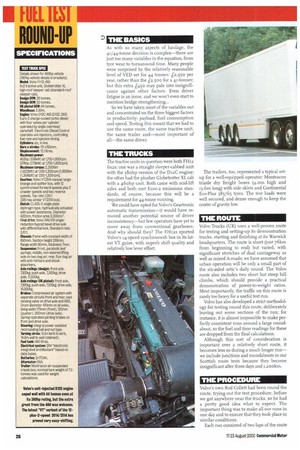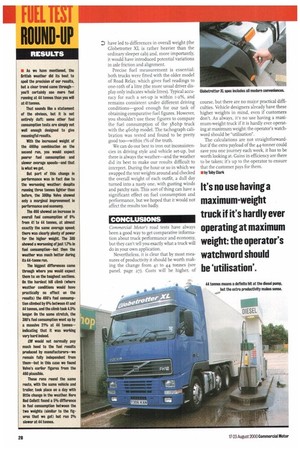THE BASICS
Page 28

Page 29

Page 30

If you've noticed an error in this article please click here to report it so we can fix it.
As with so many aspects of haulage, the 41/44-tonne decision is complex—there are just too many variables in the equation, from tyre wear to turnaround time. Many people were surprised by the relatively reasonable level of VED set for 44 tonnes: £2,950 per year, rather than the L2,5oo for a 41-tonner; but this extra L45o may pale into insignificance against other factors. Even driver fatigue is an issue, and we won't even start to mention bridge strengthening...
So we have taken most of the variables out and concentrated on the three biggest factors in productivity: payload, fuel consumption and speed. Testing this meant that we had to use the same route, the same tractive unit, the same trailer and—most important of all—the same driver.
THE TRUCKS
The tractive units in question were both FFI12 azs; one was a straight sleeper-cabbed unit with the 38ohp version of the Di2C engine; the other had the plusher Globetrotter XL cab with a 46ohp unit. Both came with mid-lift axles and both met Euro-2 emissions standards, of course, because this will be a requirement for 44-tonne running.
We could have opted for Volvo's Geartronic automatic transmission—it would have removed another potential source of driver inconsistency—but few operators have yet to move away from conventional gearboxes. And why should they? The FI-Irzs sported Volvo's 14-speed synchromesh box in its latest VT guise, with superb shift quality and relatively low lever effort.
The trailers, too, represented a typical setup for a well-equipped operator: Montracon triaxle dry freight boxes (4.om high and 13.6m long) with side skirts and Continental Eco-Plus 385/65 tyres. The test loads were well secured, and dense enough to keep the centre of gravity low.
THE ROUTE
Volvo Trucks (UK) uses a well-proven route for testing and setting-up its demonstration trucks, starting and finishing at its Warwick headquarters. The route is short (just 76km from beginning to end) but varied, with significant stretches of dual carriageway as well as mixed A-roads; we have assumed that urban operation will be only a small part of the six-oded artic's daily round. The Volvo route also includes two short but steep hill climbs, which should provide a practical demonstration of power-to-weight ratios. Most importantly, the traffic on this route is rarely too heavy for a useful test run.
Volvo has also developed a strict methodology for testing round this route, deliberately leaving out some sections of the run; for instance, it is almost impossible to make perfectly consistent runs around a large roundabout, so the fuel and time readings for these are dropped from the final calculations.
Although this sort of consideration is important over a relatively short route, it becomes less so during a much longer run— we include junctions and roundabouts in our Scottish route tests because they become insignificant after three days and 1,200km.
THE PROCEDURE
Volvo's own Rod Collett had been round the route, trying out the test procedure, before we got anywhere near the trucks, so he had a pretty good idea what to expect. The important thing was to make all our runs in one day and to ensure that they took place in similar conditions.
Each run consisted of two laps of the route —the first circuit each time got both the tractor and trailer up to a consistent operating temperature, while we took "real" measurements during the second run. Then the engine, gearbox, differential and axles would all be operating under stable conditions. By that time, too, the driver would be more relaxed and able to make a more typical run.
For the first two laps the FH 2-46o was laden to 41 tonnes, while the 380 was running at 44 tonnes. After this run the loads were transferred and overall weights verified at the nearby Trading Standards weighbridge—each time the trucks were loaded to within 200kg of the nominal GCW So for the second run (laps three and four) the 460 ran at 44 tonnes while the 380 was at three tonnes less.
We drove according to a precise regime: keep to the speed limit where practical and safe, and allow a slight overrun down hills. Gearchange and braking points were kept similar, too. Driving at the speed limit did tot make us too popular on single-lane A-roads, but it is the only way to get reasonably consistent results.
For the same reasons, each driver stuck to the same tractive unit, and to the same trailer. It would have been very easy to do one run with one trailer loaded to 41 tonnes and the other loaded to 44 tonnes, then to have simply swapped the trailers round. But this would have led to differences in overall weight (the Globetrotter XL is rather heavier than the ordinary sleeper cab) and, more importantly, it would have introduced potential variations in axle friction and alignment.
Precise fuel measurement is essential: both trucks were fitted with the older model of Road Relay, which gives fuel readings to one-roth of a litre (the more usual driver display only indicates whole litres). Typical accuracy for such a set-up is within I-2%, and remains consistent under different driving conditions—good enough for our task of obtaining comparative fuel figures. However, you shouldn't use these figures to compare the fuel consumption of the 38ohp truck with the 46ohp model. The tachograph calibration was tested and found to be pretty good too—within 1% of the truth.
We can do our best to iron out inconsistencies in driving style and vehicle set-up, but there is always the weather—and the weather did its best to make our results difficult to interpret. During the hour or so in which we swapped the test weights around and checked the overall weight of each outfit, a dull day turned into a nasty one, with gusting winds and patchy rain. This sort of thing can have a significant effect on fuel consumption and performance, but we hoped that it would not affect the results too badly.
CONCLUSIONS
Commercial Motor's road tests have always been a good way to get comparative information about truck performance and economy, but they can't tell you exactly what a truck will do in your own application.
Nevertheless, it is clear that by most measures of productivity it should be worth making the change from 41 to 44 tonnes (see panel, page 27). Costs will be higher, of
course, but there are no major practical difficulties. Vehicle designers already have these higher weights in mind, even if customers don't. As always, it's no use having a maximum-weight truck if it is hardly ever operating at maximum weight: the operator's watchword should be "utilisation".
The calculations are not straightforwardbut if the extra payload of the 44-tonner could save you one journey each week, it has to be worth looking at. Gains in efficiency are there to be taken; it's up to the operator to ensure that the customer pays for them.
11 by Toby Clark




































































































